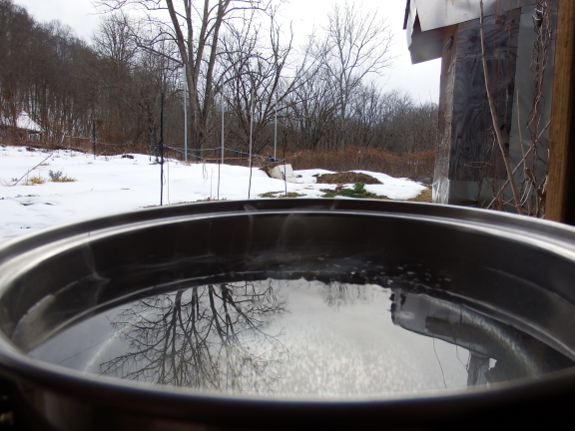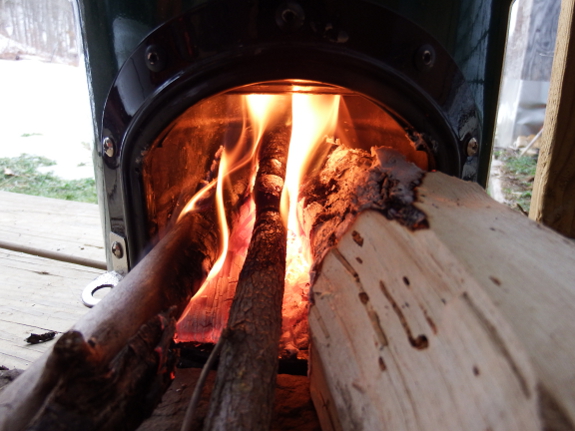
Boiling maple syrup on a rocket stove

Guess whose belly was
full and whose udder was empty when I showed up with milking gear in
hand Tuesday morning? I guess Abigail's finally going to let me off nursing duty so I can start enjoying this speedy transition from January-in-February to April-in-March.
Yes, the first speedwell
and bittercress are starting to bloom, the frogs are starting to call,
and it's time to get serious about the gallons of sap coming out of the one tree we've tapped on this side of the still-flooded creek!

My movie-star neighbor
had big plans about expanding his sugar mapling operation this year,
and I have to admit his enthusiasm was contagious. After all, tapping
maples seems to be much simpler and more dependable than getting honey
from chemical-free bees.
The kink in the maple syrupping plan, though, is boiling down all that
sap. The weather is already getting too warm to drive off the moisture
from a single tree's sap on our wood stove, and using the electric stove
seems very inefficient. But what about the rocket stove?

I filled a big pot with
box-elder sap on Monday night and decided to give the system a test run.
The good news is, one hour of rocket-stove use only consumed about half
again as much wood as is pictured above. The bad news is, the flames
only drove off about a cup or so of water, the sap ended up getting a
bit ashy, and I learned that you really do have to tweak the fuel in a rocket stove every five minutes or it'll burn down to coals.
So, no rocket-stove maple
syrup for us. I guess we'll stick to syruping on a small scale until a
better way to boil down the sap appears out of the ether. Maybe we need
to make a self-feeding rocket-stove-fuel hopper?
Want more in-depth information? Browse through our books.
Or explore more posts by date or by subject.
About us: Anna Hess and Mark Hamilton spent over a decade living self-sufficiently in the mountains of Virginia before moving north to start over from scratch in the foothills of Ohio. They've experimented with permaculture, no-till gardening, trailersteading, home-based microbusinesses and much more, writing about their adventures in both blogs and books.
Want to be notified when new comments are posted on this page? Click on the RSS button after you add a comment to subscribe to the comment feed, or simply check the box beside "email replies to me" while writing your comment.

A quick-and-easy solution would be to use that hollow kettle boiler of yours. It seems to boil water pretty easily...
But no matter how you look at it, evaporating water takes a lot of energy. So you need to maximize the heat flow from the fire into the water. You've already taken the first step by using a flat and shallow pan. That gives a lot of surface area for both evaporation and heating.
A possible improvement is to put a lid on the pan and use a vacuum pump to put the whole thing under vacuum. This will depress the boiling point of the solution and thus improves the heat flow from the fire to the liquid.
Another possibility is to heat the sap and pump it through a shower head or another kind of sprayer and then catch the droplets and return them to the heater. That would also help the water evaporate.
Alternatively you could pump air through the hot solution like in e.g. a bubble bath.
With regard to rocket stoves, rocket mass heaters usually have a horizontal burn chamber with a vertical fuel reservoir where the sticks are standing up. That way gravity feeds the wood into the fire. Such a design would probably solve your fuel feed problems.
[BTW, have you ever though about adding a mass heater to your home? It looks like a good heating method if you have a source of wood.]
Some inspiration for other wood-fired boiling apparatuses (scroll down on the last one, delicious maple-themed recipes on the way there...)
Rurification 2011 Rurification 2013 Port Potager
You could also dig an in-ground rocket stove if you could find a spot that wouldn't hit ground water, but ours still seems to require tending every 10-15 minutes.
Hope these get the gears turning!